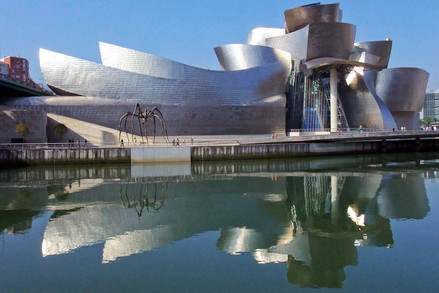Session 3: On Surfacing
- Sofía I. Capllonch

- Feb 27, 2022
- 2 min read
The aspect of architectural surfacing is a key element in discussions and comparisons between the academic and the visceral. Particularly in architecture, the details and components of a building’s surface have the potential of expressing a specific idea or conceptual vision of a designer. Analyzing the work of Moneo and Gehry once again, surfacing is yet another dimension that reveals each designer’s mindset towards the discipline. In this way, the surface of a building, when explored in a more general, architectural sense, adds another layer of analysis that allows deeper observation and comparison.
The surface of a building is tied to its form, but is by no means less important than it. Surfacing adds to the academic versus the visceral debate because it has the power of presenting architecture as a symbol; a recognizable expression of spatial poetry. But surfacing also has the power of becoming the shed that encases a structure’s interior. One interpretation is more formal while the other is more emotional. Nevertheless they both serve the same function. Whether we look at architecture as a symbol or a shed, questions of textures, colors, and material attributes define the surface, and thus, the immediate perception of any project.

Moneo’s Kursaal Congress Centre and Auditorium and Gehry’s Guggenheim Museum in Bilbao are both excellent examples of the properties of surfacing and its effect on a building as a whole. On one hand, the laminated glass panels that comprise the Kursaal’s structure offer a sense of transparency that transforms on a daily basis: by day, the building blends in its site as its interiors are generously illuminated, while at night, the interior lighting transforms the cultural center into a monumental Japanese paper lantern. This sensible approach to lighting, along with the repetition of the building’s glass panels, are representative of the building’s sober appearance, as well as Moneo’s academic formality when designing. Gehry’s Guggenheim, however, practices a completely opposite approach to surfacing: the building’s titanium scales are solid yet highly reflective. Instead of blending with its surroundings, the Guggenheim stands out dramatically. In this scenario, surfacing becomes more than a shell, as it is intrinsically related to Gehry’s architectural, contemporary sculptures.

While completely different, both of these projects made deliberate use of surface. The surfacing’s attributes are then essential in both projects, as they speak about the buildings’ character and support the designs’ forms. More so, they reveal Moneo and Gehry’s mindsets but also their influences. Finally, and in this case, surfacing bridges the gap, if only partially, between the academic and the visceral: the Kursaal and the Guggenheim each have a very distinct, poetic language that appeals to the visceral, while the surfacing’s qualities demonstrate a profound, or academic, understanding of artistic influences.







Comments